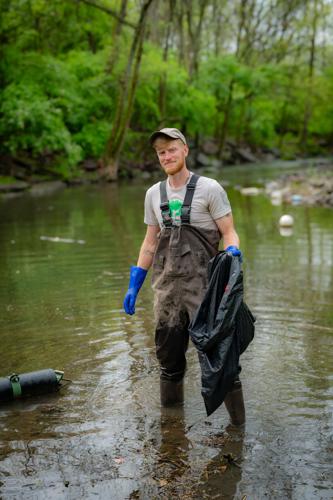
Chris Hornsby cleans a litter trap in Seven Mile Creek
Earlier this year, the Metro Council approved an agreement with the Cumberland River Compact to place a litter trap in the North Fork Ewing Creek. The creek is marked as an unhealthy waterway on the compact’s iCreek tool, which maps waterways in the Cumberland River Basin.
This will be the compact’s second litter trap. The first was installed in Seven Mile Creek. The North Fork Ewing Creek trap will be placed on Metro Water Services property along Brick Church Pike. While the agreement allows the compact onto the property, the group also needed approval from the state to place the trap in the creek bed. Now fully approved, the trap is planned for placement on April 19.
“The litter trap is kind of an easy win,” says Chris Hornsby, field operations division manager for the Cumberland River Compact. “It gets people excited because trash is such a visible issue. And you don’t really need to know anything about stream ecology to know that probably trash shouldn’t be in the streams.”
Metro agreed to permit the compact to install and maintain the trap on the property for two years, though that can be extended. The organization will anchor the trap by either tethering the device to two large trees using steel cable, or tethering it into the bank using metal stakes. According to the ordinance, the trap is made of a lightweight alloy that floats, skimming litter from the stream’s surface. The compact’s field team, led by Hornsby, will clean out the trap on a regular basis.
“Because that litter has been removed, it is better, but the stream restoration is what’s making the long-term change there,” says Meagan Hall, development and communications director for the compact. “The field team, I have to say, is a pretty interesting part of the compact because that’s what really allows us to get such a huge amount of work done — these guys are out in the community every single day.”
Hornsby says Metro Water’s staff is limited, and they can’t always do water cleanup projects themselves. But by partnering with the compact, they are able to issue grants for different operations that the field team can assist in — things like the group’s rain barrel program and tree-watering.

Chris Hornsby
“Anything they can do to improve the water quality of what’s going into the river, they’re going to help do on the front end, because it’s much less expensive to get clean water going into your stream than it is to clean up polluted water,” Hornsby says. “[Metro is] strongly motivated in terms of long-term well-being of the city’s water supply to help support these types of projects.”
Hornsby says everything his group does is about the Cumberland River watershed, which includes the land surrounding the streams in addition to the waterways feeding the Cumberland across several counties.
“Outside of the streams themselves, what happens on the land affects the quality of the water, so really, everything we do is tied back to that,” he says. “We’re trying in multiple ways to help the water infiltrate where it falls, or closer to where it falls, so that it can get into the ground and help recharge our streams naturally.”
Hornsby says work on the land and the banks helps prevent streams from drying up during periods of drought, and also makes flash floods less disruptive. Stream bank repair work is intended to help stabilize the banks, which Hornsby adds are large sources of sedimentation.
Sediment leads to issues including loss of water quality and loss of species that inhabit the streams. Hornsby explains that sloughing happens when soil gets eaten away, and the banks of waterways continually cave in, creating steep sides rather than gentle drops. Those steep banks can lead to flooding issues.
One of the signs of an unhealthy waterway, he says, is a lack of a riparian buffer — forest grasses, trees and shrubs from the edge of the stream up to a distance of 50 feet.
“If the grass is mowed up to either side of the stream, and you see that stream, you should think that’s a maimed person,” Hornsby says. “That is a seriously injured or ill person — that would be like the level of the severity of that.”
Part of the Compact’s work is to open locals’ eyes to the typically unseen issues found in our waterways — not just obvious issues like litter. It has several ways of educating the public about the work it does, but for waterways specifically, the compact has recently started a kayak cleanup series where citizens can learn more about issues like invasive species and the health of streams and banks.
“With just knowing what a few key indicators are of an issue with the stream or with the tree, it can be really powerful in terms of transforming the way [people] see the world around them as they just go through town,” Hornsby says.
Looking at the do’s and don’ts of recycling, restoring Tennessee’s waterways, protecting our caves and more




